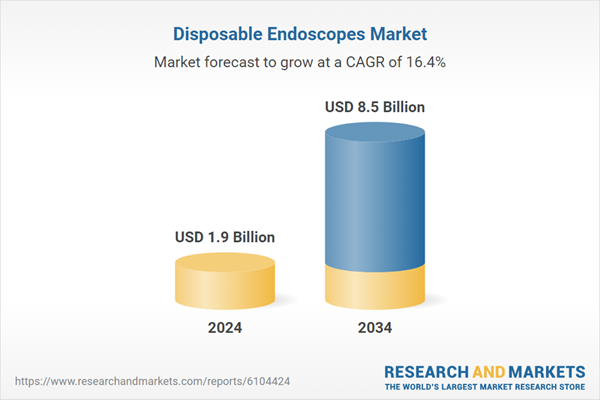Designed for single-use, disposable endoscopes - whether flexible or rigid - offer both diagnostic and therapeutic capabilities. One of their major advantages is that they eliminate the need for complex sterilization processes, making them ideal for use in point-of-care or emergency settings. The introduction of cost-effective designs integrated with CMOS sensor technology has improved imaging clarity and real-time visibility during procedures, driving further adoption in various healthcare environments, especially in resource-limited settings.
The bronchoscopes segment is forecasted to witness strong expansion, growing at a CAGR of 17% to reach USD 3.1 billion by 2034. The rising inclination toward single-use bronchoscopes stems from their ability to minimize infection risks in high-stakes environments like ICUs. These devices are now preferred for their ready-to-use functionality, especially in critical care and trauma scenarios where rapid intervention is necessary and time-consuming reprocessing of traditional scopes is impractical.
In 2024, hospitals accounted for the largest share of the market, generating 63.9%. With a high procedural load and established infrastructure, hospitals are increasingly transitioning to disposable endoscopic solutions to enhance safety and operational efficiency. Traditional reusable scopes, especially in surgical units, present a greater risk of infection transmission. In contrast, disposable scopes offer a lower infection profile, making them a preferred choice in critical departments where HAIs pose a significant risk to patient health and institutional costs.
United States Disposable Endoscopes Market generated USD 895.9 million in 2024 and is set to grow at a CAGR of 15.3% through 2034. The country’s leading position is supported by a well-established healthcare system, high surgical volumes, and early adoption of innovative technologies. Growing emphasis on infection control practices has further fueled demand for disposable solutions. Favorable reimbursement structures, regulatory support from the FDA, and substantial R&D investments from domestic companies have also created an environment conducive to rapid product development and market expansion.
Key players leading the Disposable Endoscopes Industry include Olympus, HugeMed, Boston Scientific, RICHARD WOLF, Flexicare, Ambu, Karl Storz, CooperSurgical, Parburch MEDICAL, and Hoya Corporation. Leading companies in this market are focusing on new product launches, strategic collaborations, and technological innovation to strengthen their presence. Many are investing in advanced imaging technologies and ergonomics to enhance usability and procedural efficiency.
Mergers and acquisitions are also being pursued to expand product portfolios and gain access to untapped regional markets. Some players are emphasizing scalable production capabilities and affordable designs to cater to growing demand from emerging economies. At the same time, partnerships with hospitals and clinical research institutions are helping to validate product performance and drive broader adoption across healthcare settings.
Comprehensive Market Analysis and Forecast
- Industry trends, key growth drivers, challenges, future opportunities, and regulatory landscape
- Competitive landscape with Porter’s Five Forces and PESTEL analysis
- Market size, segmentation, and regional forecasts
- In-depth company profiles, business strategies, financial insights, and SWOT analysis
This product will be delivered within 2-4 business days.
Table of Contents
COMPANIES MENTIONED
The companies featured in this disposable endoscopes market report include:- Ambu
- Boston Scientific
- CooperSurgical
- Flexicare
- Hoya Corporation
- HugeMed
- Karl Storz
- OLYMPUS
- Parburch MEDICAL
- RICHARD WOLF
Table Information
| Report Attribute | Details |
|---|---|
| No. of Pages | 90 |
| Published | June 2025 |
| Forecast Period | 2024 - 2034 |
| Estimated Market Value ( USD | $ 1.9 Billion |
| Forecasted Market Value ( USD | $ 8.5 Billion |
| Compound Annual Growth Rate | 16.4% |
| Regions Covered | Global |
| No. of Companies Mentioned | 11 |









